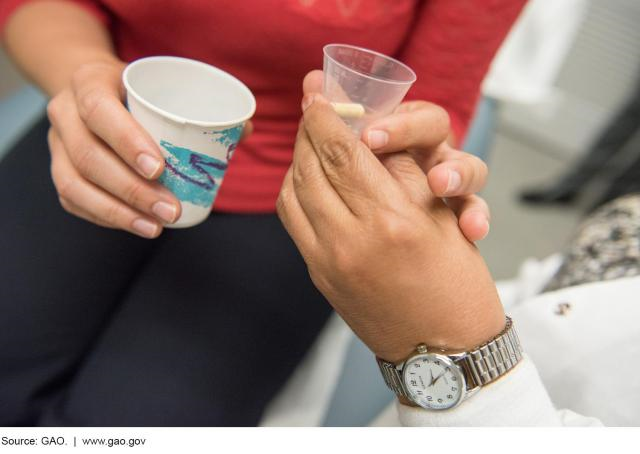Opioid Addiction: Laws, Regulations, and Other Factors Can Affect Medication-Assisted Treatment Access
Fast Facts
Overdoses of opioids such as heroin caused more than 28,000 deaths in the U.S. in 2014. Medication-assisted treatment (which combines medication with behavioral therapy) can reduce opioid addiction.
We looked at factors that can affect patients' access to medication-assisted treatment such as:
Federal laws: Laws are more restrictive when medications—e.g., methadone—are used to treat addiction rather than pain.
Practitioner availability: Qualified, registered practitioners may not be available.
Perception: This treatment is stigmatized and some practitioners are reluctant to use it.
Costs: Insurance coverage for treatment can be limited.

Photo of a medical professional giving a pill to a patient.
Highlights
What GAO Found
The Department of Health and Human Services (HHS) has stated that addressing opioid abuse is a high priority and is promoting access to medication-assisted treatment (MAT)--an approach that combines behavioral therapy and the use of medications--to combat the problem. Three medications are currently approved for use in MAT for opioid addiction--methadone, buprenorphine, and naltrexone. Methadone and buprenorphine are regulated like other controlled substances under the Controlled Substances Act (CSA) when used to treat pain and have additional requirements that apply when used to treat opioid addiction. The third medication--naltrexone--is not a controlled substance and is therefore not subject to the CSA. Methadone is a Schedule II controlled substance, which indicates a higher risk of abuse. Buprenorphine is a Schedule III controlled substance, with lower risk, and so generally has fewer requirements. For example, when used to treat pain, methadone generally may not be dispensed without a written or electronic prescription. In contrast, buprenorphine may be dispensed based on a written, electronic, or oral (phone) prescription. When used for opioid addiction treatment, the CSA and implementing regulations impose additional requirements for methadone and buprenorphine:
- Methadone may generally only be administered or dispensed within an opioid treatment program (OTP), as prescriptions for methadone cannot be issued when used for opioid addiction treatment.
- Buprenorphine may be administered or dispensed within an OTP and may also be prescribed by a qualifying practitioner who has received a waiver from the Substance Abuse and Mental Health Services Administration. Practitioners who received this waiver are limited in the number of patients they may treat for opioid addiction.
In addition to laws and regulations, several key factors can affect patients' access to MAT for opioid addiction, according to articles from peer-reviewed and scholarly journals, documents GAO reviewed, and interviews with agency officials and experts. Specifically, through these sources GAO identified the following key factors:
- The availability of qualified practitioners and their capacity to meet patient demand for MAT. For example, there were approximately 1,400 OTPs in 2016. However, sources GAO reviewed stated that they are lacking in certain locations. Furthermore, some MAT practitioners may be operating at full capacity, leading to wait lists that can affect patients' access to MAT.
- The perceptions of MAT and its value among patients, practitioners, and institutions. Some practitioners do not believe that MAT is more effective than abstinence-based treatment--when patients are treated without medication--despite science-based evidence, and there are concerns that the medications will be misused.
- The availability and limits of insurance coverage for MAT. Patients with no insurance coverage for MAT may face prohibitive out-of-pocket costs that may limit their access to it, and coverage for MAT varies for those individuals with insurance. In some cases, state Medicaid programs limit the length of time that patients can use MAT medications.
Why GAO Did This Study
The abuse of prescription opioid pain relievers and illicit opioids, such as heroin, have contributed to increasing numbers of overdose deaths in the United States, and Centers for Disease Control and Prevention data show more than 28,000 opioid overdose deaths in 2014. Research has shown that MAT can more effectively reduce opioid use and increase treatment retention compared to treatment without medication.
GAO was asked to review issues related to patient and provider use of MAT for opioid addiction. GAO examined (1) how federal laws and regulations apply when using medications to treat opioid addiction compared to using the same medications for pain management and (2) key factors that can affect access to MAT for opioid addiction. GAO reviewed federal laws and regulations pertaining to MAT medications and reviewed key documents from HHS and other sources. GAO also identified 53 articles from peer-reviewed and scholarly journals related to MAT for opioid addiction for further examination. GAO interviewed stakeholders from patient and provider groups; experts on the issue of addiction treatment; and officials at relevant federal agencies.
GAO provided a draft of this report to the Office of National Drug Control Policy, HHS, and the Department of Justice. The Office of National Drug Control Policy agreed with the report's findings. The Office of National Drug Control Policy and HHS provided technical comments, which GAO incorporated as appropriate. The Department of Justice had no comments.
For more information, contact Elizabeth H.Curda at (202) 512-7114 or curdae@gao.gov.
